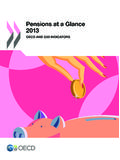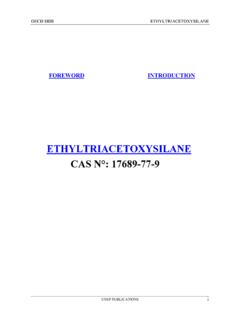Transcription of Xenia Scheil-Adlung & Lydia Sandner
1 The case for paid sick leave Xenia Scheil-Adlung & Lydia SandnerWorld Health Report (2010)Background Paper, 9 The path to universal coverageHEALTH SYSTEMS FINANCING World Health Organization, 2010 All rights reserved. The designations employed and the presentation of the material in this publication do not imply the expression of any opinion whatsoever on the part of the World Health Organization concerning the legal status of any country, territory, city or area or of its authorities, or concerning the delimitation of its frontiers or boundaries. Dotted lines on maps represent approximate border lines for which there may not yet be full agreement. The mention of specific companies or of certain manufacturers' products does not imply that they are endorsed or recommended by the World Health Organization in preference to others of a similar nature that are not mentioned.
2 Errors and omissions excepted, the names of proprietary products are distinguished by initial capital letters. All reasonable precautions have been taken by the World Health Organization to verify the information contained in this publication. However, the published material is being distributed without warranty of any kind, either expressed or implied. The responsibility for the interpretation and use of the material lies with the reader. In no event shall the World Health Organization be liable for damages arising from its use. The findings, interpretations and conclusions expressed in this paper are entirely those of the author and should not be attributed in any manner whatsoever to the World Health Organization. The Case for Paid Sick Leave World Health Report (2010) Background Paper, No 9 Xenia Scheil-Adlung1, and Lydia Sandner2 1 ILO, Health Policy Coordinator 2 Consultant 2 3 List of contents List of Understanding the role of paid sick leave: Some observations in times of What are the concepts of paid sick leave?
3 5 The notion of paid sick Organization and financing of paid sick Paid sick leave benefits and What is the current situation at the global level?..10 Incidence and patterns of paid sick Incidence of paid sick Patterns of paid sick Expenditure and Sick leave expenditure in the context of national Sick leave expenditure in the context of expenditure on social Policy lessons: Embedding paid sick leave into national social protection 4 Understanding the role of paid sick leave: Some observations in times of crises Over the last decades social protection programmes have been developed to mitigate damaging impacts from economic crises and individual setbacks. The role of social health protection has been particularly highlighted as a human right that safeguards the economic productivity of a healthy work force and serves as a social and economic stabilizer in times of crises.
4 Paid sick leave plays a crucial role especially in times of crises where many workers fear dismissal and discrimination when reporting sick. In fact, the absence of paid sick days forces ill workers to decide between caring for their health or losing jobs and income, choosing between deteriorating health and risking to impoverish themselves and often their families. Without social health protection that includes paid sick leave many people working in the formal or informal economy and living in developed or developing countries cannot afford to choose. However, there are no doubts that gaps in paid sick leave result in severe impacts on public health and the economy as recent studies on H1N1 confirmed: In 2009, when the economic crisis and the H1N1 pandemic occurred simultaneously, an alarming number of employees without the possibility of taking paid sick leave days attended work while being sick.
5 This allowed H1N1 to spread into the workplace causing infections of some 7 million co-workers in the USA In the same year, the Federal Government of Germany reported the lowest number of sickness absence ever Fears of losing one s job, restructuring, downsizing, and financial worries were identified as reasons for the dangerous and costly presence of the sick at work. The economic costs of working while sick go far beyond increased health care costs due to treating a significantly higher number of people showing more severe signs of ill health. They also involve costs due to lower productivity and subsequent impacts on economic growth and development, in addition to collective costs of growing health and social inequalities. However, many aspects of social health protection including the role, patterns and costs of paid sick leave are misunderstood or underappreciated especially during times of economic crisis and recession.
6 It is often said that paid sick leave schemes are open to abuse, especially if the benefit levels appear generous. This is undoubtedly a danger, and points to the need for strong administration. However, it is all too easy to overstate the case. ILO analyses3 of stimulus packages and policies addressing the crises reveal that cuts of social and health budgets are among the first national responses to recover the costs of bailing out those that have contributed to the crisis. Concerned are social health protection measures that provide access to health services and financial protection in case of sickness, such as paid sick leave. 5 Limited evidence is available for governments, employers and workers unions on the consequences of gaps in providing for paid sick leave and costs of failing to address the needs of the vulnerable.
7 Developing reliable internationally comparable data is constrained by the complex interplay of health and socio-economic conditions including regulations, labour market structure and vulnerability when taking up paid sick leave. Against this background, this paper seeks to focus on the existing national and international evidence and provides some insights into the concepts, patterns and affordability of paid sick leave in countries throughout the world. Further, it is argued that providing for sick leave and related income replacement is a key component of decent work and should be considered within national social protection floors. What are the concepts of paid sick leave? The notion of paid sick leave Various ILO Conventions, regulations, concepts and approaches define a broad concept of social health protection4 that includes paid sick leave by focusing on providing universal access to health care and financial protection in case of sickness.
8 In this context, financial protection includes compensation for the economic loss caused by the reduction of productivity and the stoppage or reduction of earnings resulting from ill health. Sick leave and related income replacement constitute a key component of ILO Convention 102 (Minimum Standards)5 on Social Security that sets minimum standards for social security and is deemed to embody an internationally accepted definition of the very principle of social security. It states that sickness benefits shall cover incapacity to work resulting from a morbid condition and involving suspension of The later ILO Convention 130 suggests a slightly higher standard of benefits. The ILO Decent Work Agenda defines work of acceptable quality that ensures, among others, basic The Social Protection Floor8 initiative led by the ILO and WHO established in the context of the One UN response to the economic and financial crisis, requests countries to build adequate social protection for all through basic social guarantees for every citizen.
9 9 This includes a set of essential social transfers, in cash and in kind, to provide a minimum income Key components comprise universal access to essential health care and income support for those with insufficient income and income security. The 6 concept was endorsed by the Global Jobs Pact that the International Labour Conference adopted in June 2009. These concepts are embedded in the Declaration of Philadelphia adopted in 1944 where social security has explicitly been recognized as a Human Right. It is expressly formulated as such in the Universal Declaration of Human Rights (Articles 22 and 25), and the International Covenant on Economic, Social and Cultural Rights (ICESCR, Article 9). The General Comment No.
10 1911 of the Committee on Economic, Social and Cultural Rights (CESCR)12 on Article 9 of the ICESCR defines the right to social security as encompassing the right to access and maintain benefits without discrimination in order to ensure protection from for example lack of work-related income caused by sickness, disability, maternity, employment injury, unemployment, old age, or death of a family member. These objectives demand the establishment of measures to provide support to those who are unable to make sufficient contributions for their own protection. In other words, it calls for the continuation of salary payments or income replacement in case of sickness. The concept of paid sick leave consists of two components: Leave from work due to sickness and Cash benefits that replace the wage during the time of leave due to sickness.















